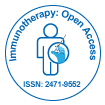
Immunotherapy: Open Access
Open Access
ISSN: 2471-9552

ISSN: 2471-9552
Commentary - (2024)Volume 10, Issue 2
Sublingual Immunotherapy (SLIT) is a cutting-edge treatment designed to help individuals manage and reduce allergic reactions. Unlike traditional allergy treatments that often focus on alleviating symptoms, SLIT aims to address the underlying cause of allergies by modulating the immune system. This innovative therapy is gaining traction as an effective and patientfriendly alternative to Subcutaneous Immunotherapy (SCIT), commonly known as allergy shots.
Understanding allergies and immunotherapy
Allergies occur when the immune system mistakenly identifies harmless substances, such as pollen, dust mites or pet dander, as threats. This activates an immune response that leads to symptoms like sneezing, itching, runny nose and in severe cases, anaphylaxis. Traditional allergy treatments, including antihistamines and corticosteroids, primarily focus on managing these symptoms.
Immunotherapy, on the other hand, works by gradually desensitizing the immune system to allergens. By regularly exposing the body to small, controlled amounts of allergens, the immune system can become less reactive over time. This method has been used for decades in the form of allergy shots, which require regular visits to a healthcare provider for injections.
The mechanism of sublingual immunotherapy
SLIT offers a needle-free approach to immunotherapy. Patients administer allergen extracts in the form of tablets or drops placed under the tongue. These allergens are then absorbed through the mucous membranes in the mouth, introducing the immune system to the allergens in a controlled manner.
The process typically begins with an initial period of daily dosing under medical supervision, followed by a maintenance phase where the treatment is continued at home. The duration of SLIT can vary but often spans several years to achieve longlasting tolerance to the allergens.
Advantages of sublingual immunotherapy
Convenience: One of the most significant benefits of SLIT is its convenience. Unlike allergy shots, which require regular visits to a healthcare provider, SLIT can be administered at home, making it easier for patients to adhere to the treatment regimen.
Safety: SLIT has a favorable safety profile. Since the allergens are introduced through the mucous membranes rather than directly into the bloodstream, the risk of severe allergic reactions, such as anaphylaxis, is considerably lower compared to SCIT. Common side effects are usually mild and may include itching or swelling in the mouth.
Efficacy: Numerous studies have demonstrated the effectiveness of SLIT in reducing allergy symptoms and improving quality of life. It is particularly effective for allergies to grass, ragweed and dust mites. For many patients, the benefits of SLIT extend beyond the treatment period, providing long-term relief.
Challenges and considerations
Despite its advantages, SLIT is not without challenges. Adherence to the treatment schedule is crucial for its success and some patients may find it difficult to maintain the daily routine over several years. Additionally, SLIT is currently approved for certain allergens, which limits its applicability for patients with multiple or complex allergies.
Cost can also be a consideration. While SLIT can be cost-effective in the long run due to reduced need for medications and doctor visits, the initial expense for the treatment can be higher than traditional symptom-relieving medications.
Future directions
Research in the field of SLIT is ongoing, with scientists exploring ways to enhance its efficacy and expand its use to a broader range of allergens. There is also interest in developing combination therapies that include SLIT along with other treatments to provide more comprehensive allergy management.
Moreover, advancements in biotechnology may lead to more personalized SLIT regimens, made to an individual's specific allergy profile and immune response. Such innovations could further improve the outcomes and accessibility of this treatment.
Sublingual immunotherapy represents a significant advancement in the management of allergies, offering a convenient, safe and effective alternative to traditional allergy shots. By targeting the root cause of allergic reactions, SLIT has the potential to provide long-term relief and improve the quality of life for millions of allergy sufferers. As studies continues to evolve, this innovative therapy may become even more integral to the field of allergy treatment, paving the way for more personalized and effective care.
Citation: Janiaud H (2024) Sublingual Immunotherapy Against Allergic Reactions and Alleviating Symptoms. Immunotherapy (Los Angel). 10:253.
Received: 27-May-2024, Manuscript No. IMT-24-31529; Editor assigned: 31-May-2024, Pre QC No. IMT-24-31529 (PQ); Reviewed: 14-Jun-2024, QC No. IMT-24-31529; Revised: 21-Jun-2024, Manuscript No. IMT-24-31529 (R); Published: 28-Jun-2024 , DOI: 10.35248/2471-9552.24.10.253
Copyright: © 2024 Janiaud H. This is an open-access article distributed under the terms of the Creative Commons Attribution License, which permits unrestricted use, distribution, and reproduction in any medium, provided the original author and source are credited.